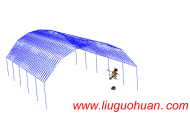高压输电塔–线体系风致动力响应分析与优化控制作者: 柳国环,李宏男 |
||||||
下载次数:
次 更多论文下载...
PDF格式(左键浏览,右键另存):
2008 年7 月5 日
摘要:建立了输电塔–线耦联体系的空间模型,利用Davenport 谱模拟了目标场地风场,采用线性弹簧模型与Maxwell 模型相结合模拟调谐质量阻尼器(tuned mass damper,TMD),采用考虑导线几何刚度时变性的非线性直接积分方法对有无TMD 的单塔、塔–线体系风致响应时程分析,进行TMD 调频参数优化控制计算,并比较了单塔与塔–线体系时程反应。分析结果表明,对单塔和塔–线体系优化控制,均可根据单塔模态分析得到的频率计算TMD 优化参数;由于背景反应的增加,使得塔–线体系总反应比单塔有较大幅度增长。 关键词:输电塔–线体系;调谐质量阻尼器;几何刚度时变性;风致动力响应;优化参数 中图分类号:P315.9;U442 文献标识码:A 文章编号:0258-8013 (2008) 19-0131-07 学科分类号:470⋅40 Abstract:A three-dimension coupled model of transmission tower-line system is established. Then, wind speed histories of the given field are generated using Davenport spectrum. In addition, a method to simulate tuned mass damper (TMD) is presented and proposed by combining linear spring model and Maxwell model. A nonlinear direct integration method considering conducting wire time-varying geometric stiffness is adopted to calculate wind-induced dynamic response of single tower and tower-line system. Moreover,control effectiveness of different optimization parameters of TMD is compared. The results of this study show that it is acceptable for both single tower and tower-line system to count optimization parameters of TMD according to the frequency computed from single tower modal analysis, and it is due to the increase of background response that make the total response of tower-line system be greater than those of single tower. Key words:transmission tower-line system; tuned mass damper; time-varying geometric stiffness; wind-induced dynamic response; optimization parameter 引言 风荷载作用下输电塔–线体系的破坏现象多有发生[1]。例如,2004 年8 月12 日“云娜”台风导致浙江地区输电线路损坏3 000 km;2005 年4 月20日,江苏一双回路500 kV 输电线路发生风致倒塌事故,一次倒塌8 基;2005 年8 月13 日泉州市一高压线路铁塔在大风吹袭下轰然倒塌,造成当地大面积停电。这些事故带来了重大的经济损失 。为此,学者们作了相关研究[2-7],文献[2]对比了单个输电塔的拟静力与塔–线体系动力响应计算结果,得到我国输电塔抗风设计方法偏于不安全的结论,但文中风荷载模拟忽略了导(地)线(以下称导线)各点高度差异的因素;文献[3]提出了一种输电塔-线体系动力分析模型,其本质是基于振型叠加的时程分析方法,该方法无法考虑风荷载作用下导线的刚度时变性;TMD 属于被动控制装置之一,邓洪州等人[4-5]利用TMD对江阴输电塔-线体系进行了风致响应控制研究,但未提及TMD 参数具体如何优化。本文建立了三塔两线和五塔四线的输电塔-线耦联体系的空间模型,以Davenport 谱为目标谱,对塔身94 个不同高度以及导线15 360 个初始几何位置模拟脉动风场,并将模拟结果与目标谱相比较;给出将线性弹簧模型与基于Maxwell 模型相结合来模拟TMD 的方法;采用考虑刚度时变性的非线性直接分方法分别对有无TMD 的塔、塔-线体系分别进行了时程分析;由于结构控制效果对TMD的调谐频率比较敏感,本文进一步比较了不同TMD优化参数对控制效果的影响,并将计算结果与文献试验结果作了比较。 结论 本文考虑到导线实际形状,根据Davenport 谱,更精确地模拟了目标场地风场;比较三塔两线与五塔四线模型的模态分析结果,选取三塔两线模型进行分析;采用考虑导线刚度时变性直接积分法对塔–线体系风致动力响应进行了计算与优化控制。根据分析结果,可得到如下几点结论: (1)本文采用了将线性弹簧模型与Maxwell模型相结合的模拟TMD 方法,它可以用于实际结构的数值计算。 (2)利用TMD 对单塔一阶振型风振响应进行优化控制,可根据单塔模态分析得到的基频计算TMD 优化参数,不需要考虑时程反应中由于二阶效应导致结构基频的减小。 (3)利用TMD 对塔–线体系风振响应一阶振型优化控制:根据塔-线体系模态分析得到的基频计算TMD 优化参数,控制效果较差,减振系数均在95%以上;根据单塔模态分析得到的基频计算TMD优化参数(b 方案),控制效果较好,位移与轴力减振系数分别为86%和84%;根据塔-线体系时程反应频谱分析得到基频计算TMD 优化参数(c 方案),控制效果最好,位移与轴力减振系数均为83%,但与b方案相比较,效果不明显。本文建议采取b 方案。 (4)与单塔相比,尽管由于导线的阻尼使得塔–线体系在共振分量处谱值降低,但由于其自振周期增加和迎风面积的增大使得塔-线体系位移反应背景分量增大,致使总反应增大。 参考文献(References): [1] Li Hongnan,Bai Haifeng.High-voltage transmission tower-line system subjected to disaster loads[J].Progress in Natural Science,2006,16 (9):899-911. [2] 张琳琳,谢强,李杰.输电线路多塔耦联体系的风致动力响应分析[J].防灾减灾工程学报,2006,26(3):261-267.Zhang Linlin,Xie Qiang,LI Jie.Dynamic wind-induced response analysis of multi-tower-line coupled system of Transmission Line[J].Journal of Disaster Prevention and Mitigation Engineering,2006,26(3):261-267(in Chinese). [3] Battista R C,Rodrigues R S,Pfeil M S.Dynamic behavior and stability of transmission line tower under wind forces[J].Journal of Wind Engineering and Industrial Aerodynamics,2003,91(8) :1051-1067. [4] 邓洪洲,朱松晔,陈亦,等.大跨越输电塔线体系风振控制研究[J].建筑结构学报,2003,24(4):60-64.Deng Hongzhou,Zhu Songye,Chenyi,et al.Study on wind-induced vibration control of long span transmission line system[J].Journal of Building Structures,2003,24(4):60-64(in Chinese). [5] 邓洪洲,苏速.江阴500 kV 大跨越输电塔线体系模型风振控制试验研究[J].山东建筑大学学报,2002,17(3):7-12.Deng HongZhou,Su su.Experimental research on wind-induced vibration control of Jiangyin 500kV long-span transmission towers and lines system model[J].Journal of Shandong Jianzhu University,2002,17(3):7-12(in Chinese). [6] Paluch M J,Cappellari T T O,Riera J D.Experimental and numerical assessment of EPS wind action on long span transmission line conductors[J] . Journal of Wind Engineering and Industrial Aerodynamics,2007,95(7):473-492. [7] Loredo-Souza M,Davenport A G.The influence of the design methodology in the response of transmission towers to wind loading [J].Journal of Wind Engineering and Industrial Aerodynamics,2003,91(8):995-1005. [8] Yasui H,Marukawa H,Momomura Y,et al.Analytical study on wind-induced vibration of power transmission tower[J].Journal of Wind Engineering and Industrial Aerodynamics,1999,8(3):431-441. [9] Hughes T.The finite element method-linear static and dynamic finite element analysis[M].New Jersey:Prentice Hall,Inc.,1987.[10] Bathe K J . Finite element procedures in engineering analysis [M].NewJersey:Prentice-Hall,Inc.,1982. [11] Chopra A.Dynamics of structures[M].2nd Edition. New Jersey:Prentice-Hall,Inc.,2001. [12] Clough R,Penzien J.Dynamics of structures[M].2nd Edition. New York:McGraw-Hill,1993 [13] 袁驷,程大业,叶康生.索结构找形分析的精确单元方法[J].建筑结构学报,2005,26(2):46-51.Yuan Si,Cheng Daye,Ye Kangsheng.Exact element method for form-finding analysis of cable structures[J].Journal of Building Structures,2005,26(2):46-51(in Chinese). [14] 沈世钊,徐崇宝等.武岳著.悬索结构设计(第二版)[M].北京:中国建筑工业出版社,2006. [15] 王之宏.风荷载模拟研究[J].建筑结构学报,1994,4(15):44-52.Wang Zhihong.Simulation of wind loading[J].Journal of Building Structures,1994,4(15):44-52(in Chinese). [16] 张琳琳.随机风场研究与高耸、高层结构抗风可靠性分析[D].上海:同济大学,2006. [17] 李春祥,刘艳霞.高层建筑TMD 风振控制优化设计[J].计算力学学报,2001,18(1):69-73.Li Chunxiang,Liu Yanxia.Optimum design of TMD for suppressing vibration of tall buildings subjected to wind[J].Chinese Journal of Computational Mechanics,2001,18(1):69-73(in Chinese). [18] Wilson E L.Static and dynamic analysis of structures:a physical approach with emphasis on earthquake engineering[M].California:Computer and Structures,Inc,Berkley,2004. [19] 爱德华﹒L﹒威尔逊.结构静力与动力分析-强调地震工程学的物理方法[M].北京金土木软件技术有限公司译.北京:中国建筑工业出版社,2006. [20] 郭勇,孙炳楠,叶尹.大跨越输电塔线体系风振响应的时域分析[J].土木工程学报,2006,12(39):12-18.Guo Yong,Sun Bingnan,Ye Yin.Time-domain analysis on windinduced dynamic response of long span power transmission line systems[J].China Civil Engineering Journal,2006,12(39):12-18(in Chinese). |
||||||
| welcome to www.liuguohuan.net |
| 天津大学 建筑工程学院 ; 天津大学 前沿技术研究院; 国家重点实验室-水利工程仿真与安全 |







